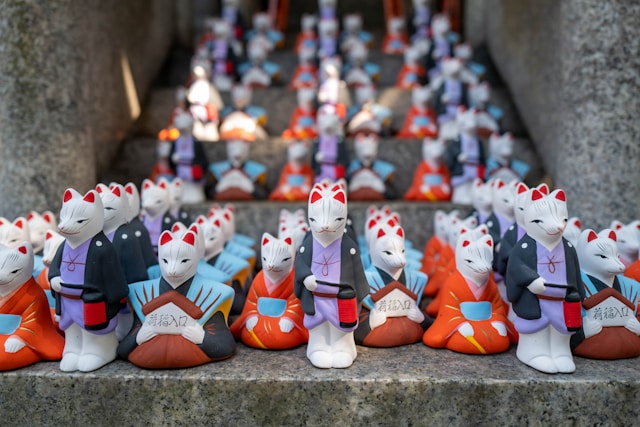Welcome to our exploration of digital marketing in Japan, where cultural intricacies blend with modern strategies to create a unique landscape for businesses.
In this post, we delve into the essential insights you need to navigate this dynamic market effectively. From the influence of familiarity and quality to the significance of customer reviews, discover how Japanese consumer behavior shapes digital marketing strategies.
Let’s uncover how to leverage these insights to enhance your approach in reaching and engaging Japanese audiences effectively.
1. Strong (often weird) advertisements

Let’s talk about the oddity of Japan. We have quite unique types of advertisements.
When you look at some famous TV commercials, you’ll immediately notice their reach. Your initial response might be something like, “Funny, but what are they trying to sell?” This happens quite often.
What this means is that many commercial creatives focus on leaving a strong impression in viewers’ minds. Often, you might feel that they go too far focusing on that sole purpose.
One example is from a company called Nisshinbo. In their TV commercial, they say, “It’s not clear what our company does” themselves. That’s a very interesting approach.
I admit that they did a great job of making me remember their name. The rest of the customer journey depends on whether or not the audience is interested enough to look up their name online.
While TV commercials are not considered digital marketing, I’m including this example to give you an idea of how marketing has been working over time in Japan.
2. Familiarity matters in digital marketing in Japan

Japanese consumers care a lot about familiarity. Many consumers choose specific products over others simply because they know those brands.
It’s a human instinct to feel more assured and relaxed when dealing with companies we have at least heard of. It’s written in our DNA that we don’t like future uncertainty.
For that reason, it’s natural to imagine that we Japanese love (or at least by default lean towards) choosing products we have heard of.
This may ring a bell for you. Remember I told you about a TV commercial for a company called Nisshinbo? They did a good job of implanting their name into my brain. I remember their name.
To be honest, I don’t know much about what they do. But when I compare a few products and one of them happens to be from Nisshinbo, and I don’t know anything about the others, I might automatically choose the one from them.
This same theory applies to big Japanese brands being more recognizable and memorable, which makes consumers more likely to choose their products.
Traditionally, the opportunities to publish effective marketing campaigns were only accessible to bigger corporations such as Panasonic, Canon, Honda, and so on. However, the game has been changing.
Nowadays, smaller startups have access to more affordable ways to market their brands and products. Think about Instagram – it has become a solid platform for any business to get exposure to potential customers.
Still, the same idea of familiarity remains crucial in consumer decision-making. The difference is that more and more business owners have access to tap into this gold mine without a huge investment.
To use this familiarity concept for your digital marketing in Japan, there are a few things you implement easily. I’ll show you below.
Business blog marketing with a Japanese platform
The idea you want to implement is that you appear as frequently as possible in front of your potential customers. You can do so with your website SEO (more about Japanese SEO here).
But what if you can’t afford to invest in creating a Japanese website or even a Japanese section on your current site? While I personally recommend making your website multilingual because of the many business benefits, if that’s not feasible, you might consider using a Japanese blogging platform instead.
The great thing about this option is that you don’t need to set up a website yourself. No technical knowledge is required. Just sign up for one of the platforms, and you can start blogging right away.
There are many free platforms out there, but I personally recommend Note. It has a strong SEO profile, which can boost the authority of the articles you publish. You can even create an account as an official “employee blog” for your business, something many Japanese companies do, either on their own site or via blogging platforms like this.
The blog posts on these platforms tend to be quite casual. They’re not usually very detailed, but you or your team members can simply share what you’re working on. For example, you might talk about the progress of your latest project, and that helps create an environment where readers feel like they’re part of the journey.
The key to building familiarity is consistency. If you decide to use one of these blogging platforms, don’t overthink it. Just start posting. This type of “team member” blogging helps convey the message that your business is approachable and relatable.
Creating this kind of approachable image for your business is important in digital marketing in Japan. I want to emphasize that this applies to B2B as well, because at the end of the day, it’s humans who decide who to work with. People want to know who is actually behind the company they’re about to do business with.
3. Take high-quality as granted

If I mention the word “Honda,” what do you associate with it? Probably your answer would be something like “durability” or “trustworthiness” – that’s the result of hard-working craftsmanship and marketing strategies.
Even though I should point out that this image could not be earned without creative digital marketing campaigns in Japan and worldwide, the image starts from the solid fact that their products are actually durable and trustworthy.
The same goes for many successful Japanese companies. So you might wonder if they all claim that their brands are tightly connected to the notion of high quality.
No, that’s not true.
The situation is that high quality is what they should have in the first place. The quality itself does not really differentiate them. If you don’t have it, you’ll get honest and bad reviews from customers.
If you have it, that’s good, but then you need to think of something unique to your service or product. In that sense, quality is like an entry point.
And do you think Japanese customers tend to trust domestic products more? Yes, that’s true. It’s not always the case, but Japanese tend to prefer Japanese products because we automatically associate “Made in Japan” products as more trustworthy and of higher quality.
But does it mean that you can’t sell things effectively in Japan in the presence of well-known Japan-made products? No, don’t worry, you can still find a way to market yours.
The reality is more nuanced. There are specific segments of people who prefer to focus on cost-effectiveness. It’s not surprising to find foreign/international products that actually offer the same quality but at cheaper prices. One notable example would be the electronics industry.
One key takeaway here is that as an international business owner or ots team member, you should make an effort to communicate that what you offer is as reliable as what is available domestically.
And remember: that’s the starting point. First, remove the mental or emotional barrier in terms of quality, and then clearly communicate your unique value proposition.
Don’t talk about quality — prove it
As a practical tip, here’s what you should do: don’t just talk about quality. Saying something like “our product is high quality” doesn’t mean much, and it often leads to weak (and very forgettable) digital marketing campaigns.
Instead, show the quality. There are a few proven marketing techniques for this:
- Offer a guarantee: Free replacement, free fixes, refunds, or a “100% satisfaction” promise. These don’t just say “high quality” — they demonstrate your confidence in the results your product delivers and show that you stand behind it.
- Showcase case studies: Share real stories and data. What happened in the past? What do your customers say? Present it as fact. This builds far more trust than simply claiming your product is high quality. In marketing, proof always works better than promises.
Quality is proven — what now?
Once you’ve made sure you have solid ways to prove the quality of your product or service. What should you do next in digital marketing in Japan?
Let me clarify one important point here.
Technically speaking, in digital marketing, things like offering guarantees or showcasing case studies should be used as a final push when potential customers are on the fence about making a purchase online.
So the correct order usually goes like this:
- Make sure your product or service is genuinely high quality
- Market your business with a unique proposition (more on this below)
- Use proof, like guarantees or case studies, to give hesitant users the final nudge to purchase
Now, this leaves one big piece to cover: your unique proposition.
This is a crucial part of digital marketing. The goal is to identify what sets you apart — the reason customers should choose you over your competitors.
The first thing I want to caution you about is this: Don’t use “quality” as your value proposition. Why? Because quality isn’t a unique selling point, it’s a basic expectation, especially in Japan.
To craft a truly compelling proposition, you first need to understand the options your target customers are considering. That means understanding your competitors.
Here’s the interesting part: Your actual competitors are often different from who you think they are. Learn more about that here: Why your real competition isn’t who you think it is.
Once you’ve identified the competitors your customers are really comparing you to, the next step is to find your differentiation, the unique angle that makes your business the obvious choice.
My favourite way is to use the Strategy Canvas. This technique maps your business and competitors in a visual way, helping you clearly identify where you can stand out. If, after mapping everything out, you don’t see anything unique about your business, that’s a red flag. It means there’s currently nothing worth marketing, which is a serious problem.
You need to find at least one way to differentiate yourself and stand out from the crowd.
Even though the Strategy Canvas isn’t a Japan-born framework, it can still be a powerful tool for your digital marketing in Japan. One of the biggest challenges you might face is a lack of understanding about who your real competitors are in the Japanese market.
Pro tip: After reading the article on identifying real competitors, take the extra step and conduct a survey with your target customers. Ask them what other options they’re considering besides you. This kind of insight can be incredibly valuable for shaping your digital marketing positioning and strategy in Japan.
4. Review-based digital marketing strategy

Japanese customers rely heavily on reviews. It’s not to say that reviews are not important in other countries. Given how our brains are wired to fear getting something worthless, it’s no surprise that we tend to seek advice from others to mitigate risks.
But here in Japan, the reliance on reviews goes even further. When you search for a new computer, what keywords would you use? You’d probably type something like “best computer for…” – of course, aiming for the best option available in the market.
In Japan, we don’t say “best computer,” but instead commonly use “recommended computer.” I don’t think it’s just a linguistic difference. I believe this example reflects how much Japanese people care about others’ opinions.
This is called uniformity. Unlike cultures in the West, in Japan, not sticking out from the crowd is often seen as caring about the community. There’s a famous proverb that goes “the nail that sticks out gets hammered” – meaning that standing out too much can bring negative attention.
I admit that this may sound a bit discomforting, but here’s the context: Japan is an isolated island. Throughout its long history, Japan hasn’t experienced as many invasions and conflicts as, say, the European continent.
What this means is that Japan developed ways to maintain peace within the country without needing to worry extensively about foreign invaders.
5. Japanese like English but don’t necessarily understand it

We love English. But that doesn’t mean all of us are fluent in English. Here’s the thing: you can see English everywhere in product design. You pick up a bag and there’s an English quote. You come across a webinar notice and there are catchy English taglines. That might sound like good news, but let me clarify one thing: the awkward news is that they are often simply wrong.
I remember coming across a mirror sold at one of the local shops that said “lame” – of course, I was confused. I laughed with my wife. It’s quite tricky to explain why this mistake happened, but to put it simply, they probably meant to say “glittery,” which was the style of the mirror.
That’s just one of countless examples of how English is everywhere but not always used correctly. What takeaway can we get from this? My piece of advice: always assume that they don’t understand whatever you write in English. Some people may, but it’s safer to assume that no one does.
That being said, when it comes to your product details, you should always provide them in Japanese. This means you need translation and localization strategies in place to effectively communicate with Japanese consumers and businesses alike.
However, don’t get me wrong. You can still sprinkle in some English phrases to convey a cool image, but make sure these don’t contain critical information that customers need to read and understand.
6. Care a lot about being in the trend

Japanese people love being on-trend. This inclination is rooted in a fear of being excluded from society or one’s community. Japan is often described as a country where individual desires and opinions are moderated to achieve harmony (known as wa) for the collective good.
That being said, following trends is often seen as one of the safest ways to secure one’s place in the community. Younger generations, especially, tend to have a strong need for acceptance from others.

Founder of Kotoli, an agency specializing in helping international businesses enter and succeed in the Japanese market, from higher-level strategic positioning, business management, and market fit, to more tactical marketing implementations such as ads, SEO, content marketing, and localization.
